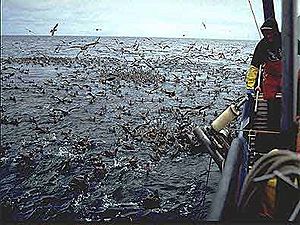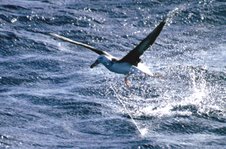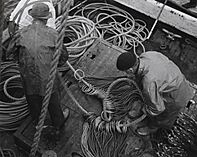Longline fishing facts for kids

Longline fishing is a way to catch fish for sale. It uses a very long main line with many baited hooks. These hooks are attached to the main line by shorter lines called snoods. A snood connects to the main line with a clip. The hook is at the other end.
Fishermen can place longlines in different parts of the ocean. Some lines float near the surface. Others rest on the sea floor. Lines can be held in place with an anchor or left to drift. A single longline can have hundreds or even thousands of hooks. This method can accidentally catch and harm many other sea animals. These unwanted catches are called bycatch.
Fishing boats that use longlines are called longliners. They often try to catch fish like swordfish, tuna, halibut, and cod. In some areas, fishermen might use only a few hooks per line. But in other places, like the Bering Sea, boats can use over 2,500 hooks. These lines can stretch for many miles.
Longlines can be set near the surface to catch fish like tuna. This is called pelagic longlining. Or, they can be set along the sea floor for fish like halibut. This is called demersal longlining. Sometimes, longlines are used with traps instead of hooks. This is for catching crabs in deep waters.
Contents
Understanding Incidental Catch

Longline fishing can accidentally catch and kill many animals. These include dolphins, seabirds, sea turtles, and sharks. This is a big problem because these animals are not the target fish. Seabirds are especially at risk when the lines are put into the water. They try to eat the bait and get caught on the hooks.
Scientists and fishermen are working to reduce this problem. They use different methods to protect other animals. One way is to add weights to the lines. This makes the lines sink quickly. Another method is to use streamer lines. These lines scare birds away from the hooks. Fishermen might also set lines only at night. This is because birds are less active in the dark. They also try not to throw fish waste into the water while setting lines. Fish waste can attract birds.
In Hawaii, longline fishing for swordfish was stopped in 2000. This was because too many sea turtles were being caught. After new rules and changes to the fishing gear, it reopened in 2004. Fishermen started using large circle-hooks and different baits. This helped reduce the number of sea turtles caught. However, the fishery closed again in 2006 when too many loggerhead turtles were caught.
Longline fishing is also a major threat to albatrosses. Many albatross species are in danger of disappearing. Albatrosses and other seabirds eat fish waste. They are attracted to the baited hooks. They get caught on the lines and drown. It is thought that about 8,000 albatrosses die this way each year.
To help albatrosses, a special device called a Hookpod has been created. This device can be put on longlines. It helps prevent seabirds from getting hooked. In New Zealand, some fishing boats started using Hookpods in 2020. In the first six months, they caught zero seabirds.
Microplastics in Our Oceans
Plastic fishing gear can cause ocean pollution. Longline fishing equipment and drift nets are often made of plastic. Over time, these plastics break down into tiny pieces. These tiny pieces are called microplastics. They can also be lost or thrown away. Microplastics harm marine life and the ocean environment.
Safety for Fishermen
Fishing can be a dangerous job. In the United States, a study looked at injuries among fishermen. It found that longline fishermen had a higher risk of non-fatal injuries. About 35 out of every 1,000 full-time workers were injured. This number is about three times higher than the average for workers in the U.S.
Historic Images
See also
- Trotline






